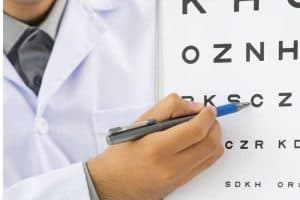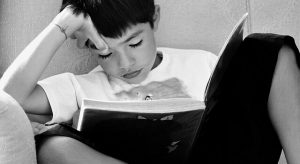Visual skills are a vital pillar of learning.
Every student needs strong visual skills to excel at school.
Your child’s ability to learn in and out of the classroom depends on a number of factors, including the strength of their visual skills.
Here are 6 top myths and facts about vision-related learning problems.
Myth #1: Our sense of sight is equal to the other 4 senses
Fact: According to the American Optometric Association, as much as 60% of the entire brain is involved with the gathering or interpretation of visual information.
This means that our sense of sight takes more brain capacity than all the other senses combined.
Because of this, it should come as no surprise that children who have vision difficulties often have difficulties with learning as well.
Myth #2: My child’s vision is 20/20, so their learning issues can’t be vision-related
Fact: 20/20 vision is important, but it is by no means the only consideration parents should have when assessing if a child’s learning problems are vision-related.
Even if your child has 20/20 vision, they may still be struggling with mastery of certain functional vision or visual processing skills that can seriously hinder their ability to learn.
Functional vision skills involve the coordinated, efficient and accurate eye movements required to gather visual information. This visual information is then interpreted by the brain to create a single unified picture of the world around you.
If your child has problems with these skills, they may have difficulties with depth perception, keeping their spot on the page while reading or keeping objects in focus as they come closer and/or move further away.
This can cause symptoms such as blurry or double vision, headaches and eye strain, especially during activities such as reading or writing.
Visual perception skills involve the correct and efficient interpretation of visual information sent to the brain from the eyes.
If your child is having difficulties with these skills, you may notice that they have a hard time retaining information they read, or spelling on grade level. This could be due to problems with perception skills such as visual memory or visual processing.
Myth #3: Only ADD/ADHD impacts my child’s attention, not vision problems
Fact: Many of the symptoms associated with ADD/ADHD are also features of certain vision issues that can cause attention difficulties.
Difficulties with reading retention, attention span and apparent hyperactivity are symptoms of vision issues that can easily also be mistaken for ADD/ADHD.
If your child has been diagnosed with ADD/ADHD or you suspect they may have it, it is worthwhile to consult an eye doctor to ensure that certain vision disorders aren’t at play in your child’s learning difficulties.
Further symptoms of vision problems that can be mistaken for ADD/ADHD and other learning disabilities include:
- Reading slowly while using a finger
- Trouble keeping their place while reading texts
- Avoidance of close work and reading
- Problems with development of eye-hand coordination
- Difficulties retaining things that they read
- Falling behind socially or academically compared to the rest of their class
SEE RELATED: Could a Vision Problem Impact Academic Performance? Top 5 FAQs
For more information on vision-related learning difficulties and how they can be treated, contact an eye doctor near you.
Myth #4: School vision screenings will identify any vision issues that can impact my child’s learning
Fact: School vision screenings are often mistakenly believed to be the same as the yearly comprehensive eye exam your child receives with their local optometrist.
Unfortunately, while these screenings are able to diagnose cases of myopia and similar refractive errors, they are not equipped to detect the vast majority of vision problems that could cause learning difficulties.
Your child’s eye doctor is equipped and trained to run important tests as part of a comprehensive eye exam to check your child’s mastery of functional vision skills that would be missed at a school vision screening. These skills include eye teaming and tracking, convergence/divergence and visual accommodation.
Your optometrist will also check your child’s eyes for signs of amblyopia and strabismus that can cause permanent vision loss if untreated.
If your eye doctor diagnoses your child with a refractive error, they can prescribe eyeglasses or contact lenses.
If they diagnose your child with functional vision or visual perception difficulties, your optometrist can recommend a number of solutions, including vision therapy.
Myth #5: You can spark a child’s interest in reading by just finding the right book
Fact: Sometimes, a child’s disinterest in reading has nothing to do with the types of books given to them.
If they’re not able to read properly, or reading is uncomfortable due to vision issues, it can often be easier and more comfortable for your child to simply give up on reading.
Refractive errors such as myopia or astigmatism can lead to blurry vision while reading, as well as headaches from the constant need to squint to keep text in focus.
Functional vision issues can make reading a chore as well. Convergence insufficiency, for example, makes it difficult for your eyes to converge on a single spot up-close. This leads to double or blurry vision and headaches from the constant effort to maintain single vision while reading.
Visual tracking issues can also cause them to constantly lose their place while reading, leading to reading comprehension difficulties.
A comprehensive eye exam with your eye doctor can help identify vision problems getting in the way of your child’s enjoyment of reading. Treating these problems can get them back on track and make reading fun.
Myth #6: Vision therapy will not help boost a child’s learning ability
Fact: Vision therapy is an evidence-based treatment regimen to improve both functional visual skills and visual processing.
Since problems with these two types of skills can have a detrimental effect on your child’s ability to learn, fixing them can boost their learning potential.
Vision therapy involves a doctor-prescribed series of scientifically-proven in-office and at-home eye exercises that strengthen the eye-brain connections.
Depending on your child’s needs, vision therapy aids such as balancing boards, prism lenses and wolff wands may be used to further promote the effectiveness of the therapy.
While each case is different, vision therapy generally takes about four to six months to be fully effective.
LEARN MORE: Vision For School
If your child has any learning difficulties, schedule an appointment with an eye doctor near you.
If a student has poorly developed visual skills, it can have a significant impact on their academic and athletic success.
Here are 6 top myths and facts about vision-related learning problems and how they can be treated.









